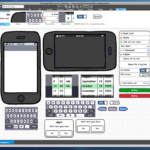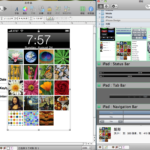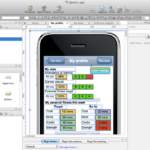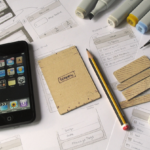Pen and Paper Vs. Sketching Tools
Quite a few people have asked me over the years why I, as an interaction designer, do not use some of all the sketching and prototyping software that is out there, and why I still draw by hand despite the availability of all of these really smart and practical tools. Here’s why:

When I sketch a first prototype of a piece of software for a customer, then despite having done my homework well exploring the customer’s wants, and researching the users’ needs, I usually never get it right the first time. Understanding a new domain of expertise is a process that takes time and effort, and I always learn new things about a domain when I present a first prototype sketch to the customer and/or the users. There were things they forgot to tell me the first time, things I did not fully grasp the importance of initially. These new pieces of information usually causes the interaction design to change, as it should. But….

I find that I tend to be more reluctant to making the required changes if I have been doing my sketching using a tool rather than pen and paper. And I recognise the same behavior in other designers too. I thought about why that was and the answer turns out to not only be simple, but also well known:
One of the original reasons for making wireframes before coding a piece of software, was that developers tended to be hesitant towards making changes to the design , because it meant a lot of recoding, thus costing time and money. To limit the amount of recoding, wireframing (among other things) was introduced, since sketching a wireframe on a piece of paper is a lot faster than coding it, and therefore a lot easier to redo if you get it wrong the first time.

But as wireframing has become more and more common as a part of the development process, various tools such as Axure, Omnigraffle and Balsamic have started emerging too. I find that in general it takes me a lot longer to make a wireframe in a sketching tool than it takes sketching it by hand. Hence, when I don’t get the design right the first time, this means a lot of resketching which takes time, and I then find myself hesitant to change the design as it means a lot of extra work redoing the wireframes.

Hence, the more time and work we have invested in a given task, whether it is coding or sketching, the less inclined we are to change it, and we will argue against better judgement to avoid having to change it. Because of this, I have gone back to drawing wireframes by hand as each wireframes doesn’t take me very long, and the amount of work lost if I have to redo a sketch is thus minimal.
So get out your pen, paper, eraser and ruler and start sketching the old-fashioned way!
Follow the “Interaction Design and Usability Course” Feb 4-5, Amsterdam
Janne Jul Jensen is an experienced trainer and she will also offer one of her courses in Amsterdam. In February 2015, Janne will teach the course Interaction Design & Usability Course. In the 2-day course you will get an all round introduction into interaction design and usability. Read more about the course here!
About Janne Jul Jensen
Janne Jul Jensen is, within her area of expertise interaction design and usability, a sought after speaker by both educational institutions, conferences, the public sector and companies, but on a daily basis she mainly applies these skills to the mobile app projects within Trifork, such as apps for Danske Bank, Radiometer A/S, Roskilde Festival, KMD and DSB.
Watch one of her talks on Youtube!